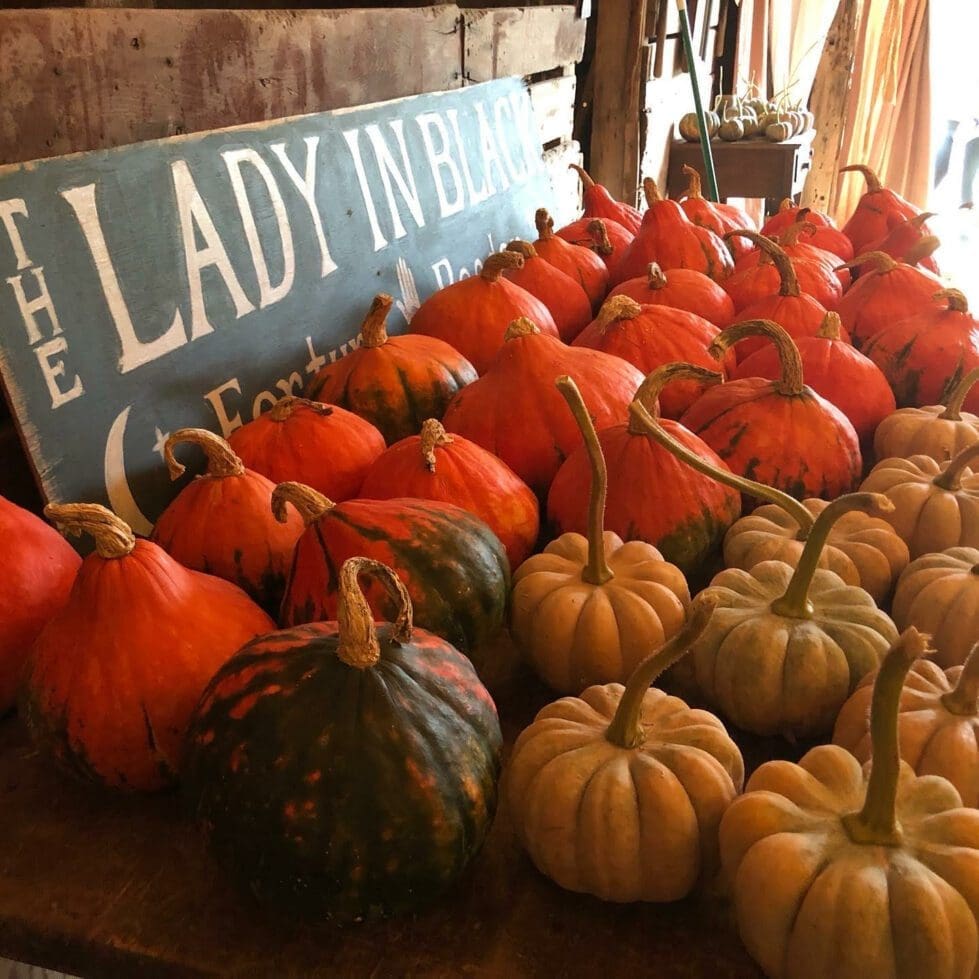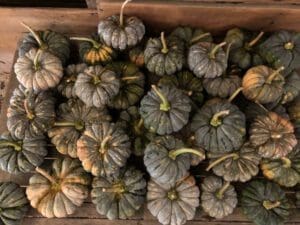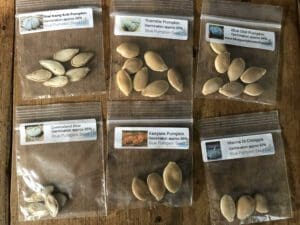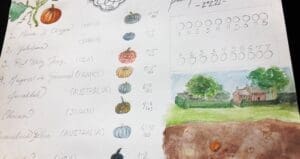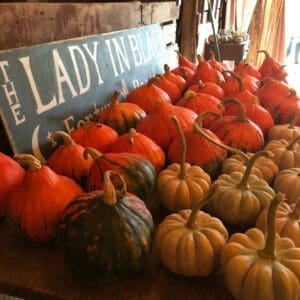
Greg and Dawn Shelton sold their pumpkins at Poplar Hall and at The Revisionists production at Rockwood Museum. Photo by Greg Shelton.
The Great Pumpkin would approve.
Torrential rains and hail in Colorado have sparked a pumpkin pay-it-forward act of kindness from the owners of Poplar Hall, a historic farm near Newark.
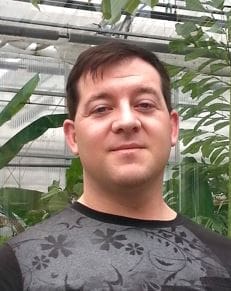
Brian Santiago
Brian Santiago of Colorado Springs has had his heirloom pumpkin crops wiped out three times by storms and hail as big as a quarter or half dollar.
No pumpkins means no seeds for his Blue Pumpkin Seed Co., which mails seeds for rare, heirloom, organic and hybrid varieties around the world.
Greg and Dawn Shelton, who own Poplar Hall, have been buying seeds from Santiago, with Greg and Brian bonding over their love of the blue varieties so much that they talk about once a month.
After hearing about Santiago’s plight, Greg Shelton volunteered to plant a larger patch than he originally planned and send seeds back from every one of the 25 varieties that they plant.
“It helps us stay in business,” Santiago said last week from Colorado, in the middle of the 12th hail storm this summer. In the background, ice could be heard plinking off the ground, roof and concrete steps.
Santiago said Blue Pumpkin wholesales some seeds, but he and his wife grow their own heirloom pumpkins to package and sell.

Greg Shelton, Photo by Tim Miller
“There’s some rare kinds that I have none left of,” Santiago said. “If my pumpkin plants don’t make it, he’s kind of my insurance policy. He’s gonna grow those and then I’ll be able to carry that line on since they’re so difficult to get ahold of.”
The Sheltons had added a pumpkin patch to Poplar Hall, which is on the National Registry of Historic Places, partly because they love Halloween and harvests events so much.
The two-story house was built in the mid-1700s in Pencader Hundred, and the property includes six other buildings. The Sheltons are only the fourth owners.
Not just any pumpkin would do, Greg Shelton decided when he put in his patch. He likes pumpkins that are a bit off-center, with unusual textures or colors.
An ad showing a muted gray blue pumpkin led Shelton to Blue Pumpkin Seed Co.
“I realized he was going for a different style and different look and had knocked it out of the park because he has a really amazing collection of seeds from all over the world,” Shelton said.
From insurance to pumpkins
Santiago founded the company in 2020. He had been working at a Progressive Insurance call center for 11 years when he decided to take a break.
He and his wife started selling vegetables and pumpkin seeds from their garden.
“It just started to take off and so I was able to quit my job,” Santiago said.
They started an Etsy site that went well and then launched their own website. Seeds come in small clear plastic bags and seem to sell for $4 a bag.
Blue Pumpkin last year sold 122 varieties of pumpkin seeds and Santiago still hopes this year to be able to push that up to 150.
Pumpkins were a kind of natural crop for him. Fall and Halloween are two of his favorite things.
“I would decorate the house with my mom, and then I’ve just always loved pumpkins,” he said. “So when we found our property in 2018, I started a little pumpkin patch and over the past few years we have just kind of dedicated our entire front and back lot to them.”
On a normal year, he and his wife will clean and dry the seeds through January.
A lot of the people who buy his seeds are small farmers, Santiago said.
His favorite pumpkin is the Blue Doll, a typically shaped pumpkin with a pale blue gray textured skin.
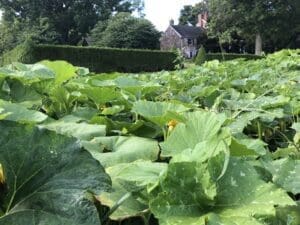
Last year’s pumpkins thrive in the field by Poplar Hall; the field will be bigger this year.
Shelton, whose favorite color is blue, can reel off the names of some of Santiago’s pumpkins and their home country: The New Zealand Blue, the Queensland Blue from Australia, the Jarradale pumpkin from Australia.
The Sheltons grew about 450 pumpkins last year, selling most of them from their farm.
“The beauty of it was that it was in my style,” said Shelton. “My brand is really about doing things a little left of center and not doing the normal yellow and orange pumpkins that everyone gets on the roadside.”
They’re not only fun to look at, but most are delicious to eat and have interesting scents, Shelton said.
“Americans, East Coast Americans, we’re not really taught about the flavors of a pumpkin,” he said. “When you think about just harmlessly carving something and putting a light in it, and watching it die at the end of October, you throw it in the trash.”
When Shelton produced “The Revisionists: A Haunted Victorian Walk” last year at Rockwood Mansion and Park, he decided to sell some of the pumpkins there. They were a big hit. They’ll be back again this year Oct. 13-14, 20-21 and 27-28.
When Shelton planned to expand his patch, he asked Santiago for some recommendations. They included a troll pumpkin, which has a blue-gray crown, as well as a carnival pumpkin, so named because it has a lot of colors.
Last year, the Sheltons grew 15 varieties, almost all heirloom. This year they will grow 25.
He can’t wait to see them as they grow.
“If you’ve ever been to a really thriving pumpkin patch, you know the leaves and the foliage grow up to knee high, waist high, and then you have to go in between to see what’s growing,” Shelton said. “Once you get under those big leaves, you’ll see all kinds of interesting colors and striations in the flesh. It’s very cool.”
One of the fun things about growing pumpkins, Santiago said, is that the vines can be stretched into a straight line so it’s easy to track the varieties.
Shelton said he and his wife plan to open at least one pumpkin of every variety, strain out the seeds, wash them, dry them and mail them to Santiago.
Shelton said most pumpkins have 75 to 150 seeds.
After getting as much pulp off the seeds as possible, they are rinsed and laid out on a paper towel and left to dry for about 10 days.
Properly dried pumpkin seeds can be saved and used for four years, Shelton said.
“Anyone can do it,” he said. “It’s really easy to do, but sometimes people forget it’s easy and they decide to buy new ones every year.”
Shelton and Santiago are also working on an idea called a Pop-Up Pumpkin Patch.
The pumpkinheads’ idea is that people who want to grow pumpkins — or squash because Santiago sells seeds for those, too — could borrow the land from a friend or farm a community garden plot using Santiago’s seeds.
“They will grow like crazy,” Shelton said. “Most pumpkins take 90 to 120 days. Obviously, we’re not talking about giant pumpkins. But you can get some really interesting ones.”

Betsy Price is a Wilmington freelance writer who has 40 years of experience, including 15 at The News Journal in Delaware.
Share this Post


